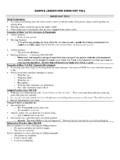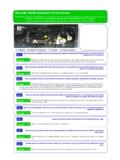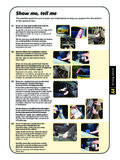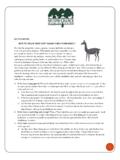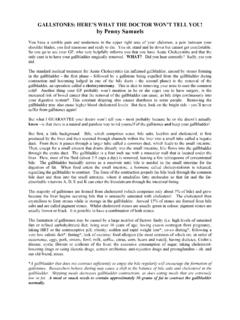Transcription of What Can Neuroscience Tell Us About Why Print Magazine ...
1 What Can Neuroscience tell Us About Why Print MagazineAdvertising Works?A White Paper from MPA The Association of Magazine MediaScott McDonald, |Nomos Research |September 2015 Table of ContentsA Paradox |3 What Neuroscience Tells Us About How We Read |5 Seeing the Brain in Action| 5 Visual Aspects of Reading| 6 Interpretation, Understanding, Remembering| 6 The Principle of Brain Plasticity and Worries About Digital Reading| 7 What Do We Know About Paper versus Screen Reading? |8 Scanning versus Deep Reading| 8 Comprehension and Recall| 9 Hyperlinks, Multitasking and Cognitive Load| 10 Haptics, Tactility and Multisensory Reading| 11 Emotion and Memory Retrieval| 13 Format Preference| 14 Conclusion and Executive Summary|15 References|16 What Can Neuroscience tell Us About Why Print Magazine Advertising Works?A White Paper from MPA The Association of Magazine MediaScott McDonald, , Nomos Research, September 2015.
2 Produced by MPA The Association of Magazine Media. 757 Third Avenue, 11th Floor, New York, NY 10017 Copyright 2015. All rights reserved. Can Neuroscience tell Us About Why Print Magazine Advertising Works?A White Paper from MPA The Association of Magazine Media |Scott McDonald, |Nomos Research |September 2015A ParadoxConsumer demand for Magazine media (capturing all platforms and formats throughwhich Magazine brands distribute content) remains strong, despite a popular narrativethat often portrays Print magazines as going the way of the dinosaur. Consumerscontinue to read Magazine media in their various forms and formats, in Print and onthe various digital platforms and devices on which they are available. In fact, whenyou tally up all of those platforms and points of contact, consumer demand for manymagazine media brands appears to be more robust than ever (MPA, 2015).
3 Consumersaccess their Magazine media content via the web, different apps, video streamingservices and even podcasts. As Magazine media move into ever more diversedistribution channels, consumer demand grows apace. Even when attention is focused solely on younger consumers and only on thetraditional printed format, the audience trend statistics show greater aggregateconsumer demand for many categories of Print magazines now than in past decades(McDonald, 2011; McDonald, 2007). For popular Magazine media categories such asfashion, celebrity and men s interest, a greater percentage of Americans ages 18 to 24 read Print magazines now than was the case 10 or 20 years ago. What s more, MRI data from 2014 show that 95% of Americans under the age of 25 read printmagazines, the highest rate of all age groups (MPA 2015). Critics sometimes point to declining newsstand sales as evidence of weak demand for Print magazines; whileit is true that newsstand sales are continuing a long decline, many factors other thandemand contribute to that trend.
4 For example, distributor consolidation, less frequenttrips to supermarkets, the rise of big-box stores, self-checkout, and ubiquitoussmartphones have all reduced consumer exposure to newsstand facings andopportunities to impulse-buy Print magazines at the newsstand. However, with theexception of newsstand sales, consumer demand for Print magazines has been stable and, in some areas, growing. When you consider those factors, along with thebroader indicators of demand, a narrative asserting that Print is dead is wrong at least from the perspective of consumer , the advertising side of the Print Magazine business is much moreproblematic. The growth of digital ad spending has come at the expense of Print , and even as Magazine publishers have transformed their businesses to try to capturesome of the growth in digital ad spending, they have struggled to make up theshortfall from declining Print spending.
5 As advertisers have become more interestedin targeting technologies and applications of Big Data to create new occasions for admessaging, their interest has waned in the older, more traditional, more expensive quality media. As Michael Wolff points out in his recent book, (Television is the NewTelevision: The Unexpected Triumph of Old Media in the Digital Age), a large portionof the advertising business converted itself from its dual emphasis on Print andtelevision to a new emphasis on digital together with television (these became competingpower centers within agencies) (Wolff, 2015). Digital was cool, exciting and new. Itattracted ever larger shares of marketer budgets, to the detriment of Print Can Neuroscience tell Us About Why Print Magazine Advertising Works?A White Paper from MPA The Association of Magazine Media |Scott McDonald, |Nomos Research |September 20153 Yet there is a paradox: Though Magazine publishers have to fight harder for advertiserdollars, Magazine media, particularly in the Print format, consistently perform well inthe quantitative market mix models those same advertisers commission to evaluatethe effectiveness of their media spending.
6 These studies show that Print magazinesdeliver strong advertiser ROI even when a lot of other media are in the mix (Briggs,2013; Collins, Riggimenti and Vogel, 2007; Cardarelli et al, 2007; Kilger and Romer,2013; Kimelfeld and Phansalka, 2013; Bickel, Cleveland and Wood, 2013; Klein andWood, 2013). Independent, media-neutral meta-analyses conducted by many of theleading firms in the field of market mix modeling, including Millward Brown,Marketing Evolution, Dynamic Logic, Market Share Partners and others, havereplicated these findings. Studies based on market mix models tell us that Print magazines perform well againstimportant advertiser KPIs such as ad recall, persuasion, brand consideration, purchaseintention and actual purchase even when there is a lot of noise from other mediapresent in the marketplace. But these studies don t give us a clue as to why printmagazines continue to demonstrate such is the purpose of this paper to investigate this question: Why do Print magazinesdeliver the goods for advertisers even when ad messages via other media on otherplatforms have saturated Print Magazine audiences?
7 In particular, this white paperconsiders the possibility that the secret of Print Magazine advertising performancemay be the continuing importance of Print -on-paper as a delivery mechanism formagazine media. After all, Print -on-paper remains the unique province of magazinebrands, newspapers and direct mail. Among the media usually included in the marketmix model studies (TV, web, Magazine media, radio), only Magazine media offer apaper-based delivery vehicle. Perhaps ad messages delivered through this venerableplatform offer something uniquely valuable, and have an impact on consumers thatperseveres even in the digital burgeoning academic literature describes the differences between reading onpaper and reading on screen, drawing much of its data from the new and excitingfrontier of Neuroscience research. The immediate purpose of this paper is to reviewthat technical literature and translate it to a business-oriented, nontechnical input to this study, Nomos Research performed a scan of the published researchfrom the last 10 years in the leading peer-reviewed journals for the cognitive sciences comprising Neuroscience , cognitive psychology, learning and developmental psychology,linguistics and anthropology to see what that research tells us About Print and on-screen reading in the context of modern digital environments.
8 Of course, there could be noncognitive reasons for the persistent strong performanceof Magazine media in market mix models. Perhaps they extend the reach of an adcampaign to a degree our limited cross-platform media measurement has not yetcaptured. Perhaps because of their slower audience accumulation pattern, printmagazines deliver their ad messages in a sequence and timing that amplifies theeffects of the more immediate electronic media that consumers have already Can Neuroscience tell Us About Why Print Magazine Advertising Works?A White Paper from MPA The Association of Magazine Media |Scott McDonald, |Nomos Research |September 20154 Perhaps Magazine media have more credibility or engage with consumers at adifferent and more receptive mood moment. Perhaps Magazine media reach more-influential consumers, who then talk to their friends and activate network it is simply that ad messages received through different channels are moreeffective than ad messages repeated more frequently through the same channel.
9 Over the years, various studies have explored these possibilities, and none of themcan really be ruled out. In this white paper, we focus on the possibility that it might be our cognitiveprocesses when we read Print magazines that cause these impressive results in marketmix models. A lot of scientific research in the past decade has studied how our brainswork. What light does this research shed on the differences between reading onpaper and reading in a digital environment? It is the purpose of this review to bringthis science to a broader business-oriented Neuroscience Tells Us About How We ReadBefore discussing the studies that compare reading on paper to reading on screen, itis worth spending a moment describing, in drastically simplified form, the work doneby the hard-core cognitive neuroscientists to map the processes by which we read. Seeing the Brain in ActionBrain imaging technology allows us to see what areas of the brain are activated whendoing certain activities or encountering different stimuli.
10 Cognitive Neuroscience hasshown that reading involves a suite of processes that sequentially activate differentparts of the brain and involve not only visual, but also cognitive, affective and linguisticprocesses (and the brain regions associated with each). Accordingly, much of theliterature under review here focuses on one or another subspecialties related to reading: Visual processing and parsing of symbols Mapping symbol combinations (words) to a remembered lexicon how words and contextual information are stored in memory working memory, short-term memory and long-term memory recall, comprehension and chronology reconstruction Attention, focus and the brain executive function that directs our attention together with those things thought to be the possible enemies of attention (distraction, multitasking, cognitive overload) Emotions generated by reading, especially as they affect memory and attention Multisensory dimensions of reading including the study of haptics, tactility, and the use of hands in the gathering and retention of informationStudies that compare human brain anatomy to that of other primates (or to ourevolutionary ancestors)
